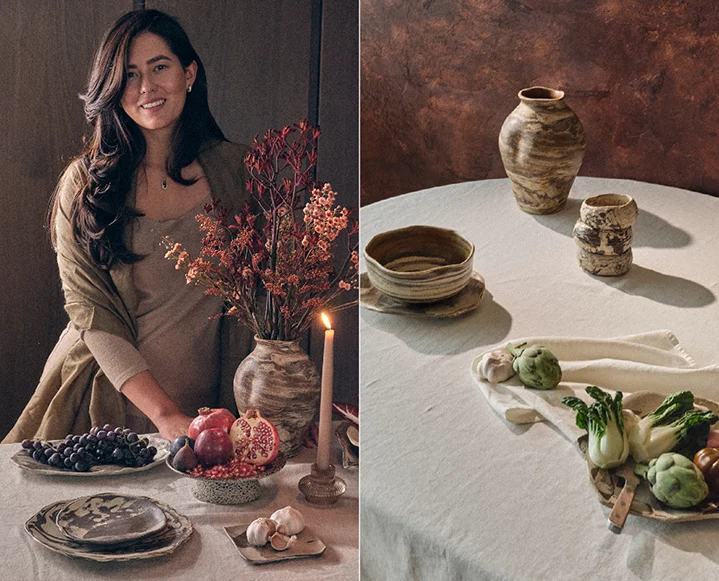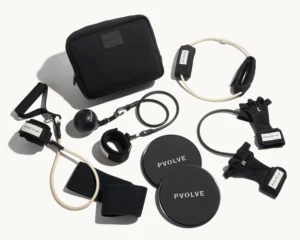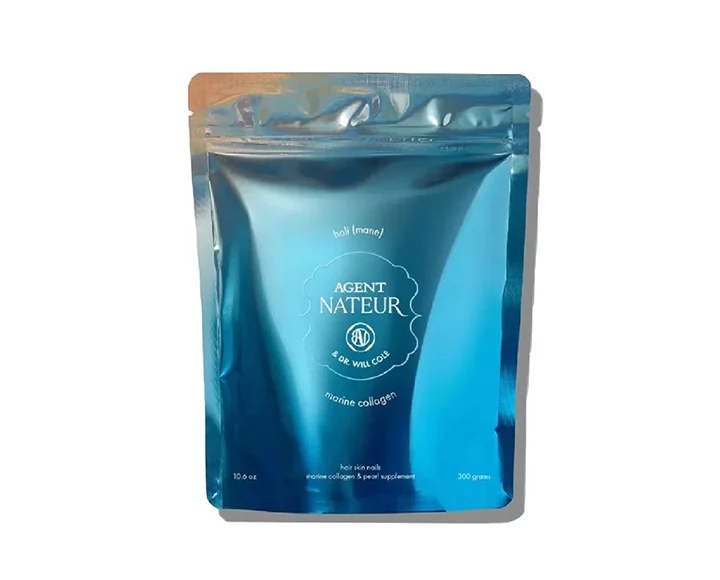There’s something undeniably magical about a beautifully set table—it’s where meals become memories, where conversation flows effortlessly, and where even the simplest ingredients feel like an occasion. But creating an elegant, intentional tablescape isn’t just about the right plates and linens; it’s about storytelling, balance, and embracing the beauty of imperfection.
Jazmin Valdes Hamid, the visionary behind Hashi Home, a New York-based homeware brand that fuses the Japanese philosophy of wabi-sabi with the warmth of Peruvian design. Through handcrafted ceramics and timeless pieces, Hashi Home redefines the way we gather—bringing an effortless yet elevated aesthetic to the modern table.
We sat down with Jazmin to talk all things tablescapes—how to create a setting that feels intentional yet effortless, how her cultural roots influence her design aesthetic, and why a little imperfection makes for the most memorable dining experiences. Whether you’re hosting an intimate dinner or just looking to make everyday meals feel a little more special, her perspective will have you rethinking the way you set the table.
Setting the perfect table with Hashi Home
What inspired you to start Hashi Home, and how do you see it redefining the way we think about home décor?
Hashi Home is a reflection of my Japanese and Peruvian heritage. 2 geographically distant cultures– yet both share a deep reverence for nature, craftsmanship, and the beauty of simplicity. Growing up, the women in my life taught me the importance of celebrating the small details and the value of making things with your hands. This was a way for me to merge my obsession with design and roots in a way that felt functional and meaningful.
Home décor is not about filling your space up with things, rather curating meaningful objects that reflect who we are and how we live. Our homes are an extension of ourselves, and the objects we choose should resonate with us on a deeper level. For me, that’s slowing down and enjoying the quiet simple moments. At Hashi Home, we believe in elevating everyday routines into rituals through design.
Your designs blend the Japanese philosophy of wabi-sabi with Peruvian design elements. Can you describe a specific piece or collection that best exemplifies this fusion, and what story does it tell?
Our Duna and Dunita Sets are the perfect example of blending wabi-sabi with Peruvian craftsmanship. The plates are handcrafted by master artisans in Peru using a traditional Japanese technique called “nerikomi,” which involves layering different hand dyed clays to create intricate designs that mimic nature’s raw beauty. Each plate is one-of-a-kind, with variations in shape, texture, and color—imperfections are not only expected, they’re encouraged. It was important for me that the designs visibly show the trace of the maker’s hands, honoring the process and the artistry behind each piece.
The earth tones and organic shapes reflect both the simplicity and the depth of nature, while the process honors the craft of both Japanese and Peruvian traditions. This collection tells a story of how different cultures and philosophies can come together to create something truly timeless and beautiful—celebrating imperfection, individuality, and the artistry of handcraft.
 What are the key elements of a minimalist yet elevated tablescape that can instantly transform a dining experience?
What are the key elements of a minimalist yet elevated tablescape that can instantly transform a dining experience?
The best go-to is a neutral tablecloth with texture; think linen or cotton. These materials have a natural, understated elegance that create the perfect base layer without overwhelming the space. The key to a minimalist table is quality over quantity. Focus on a couple standout pieces– like glassware, plates, or pitchers– that have a strong aesthetic presence. Layer them in with simple pieces like silverware, napkins, and candles. When you choose a few carefully designed elements, they set the tone and create a refined look that feels effortless and elevated.
What’s your approach to mixing materials like ceramics, wood, and textiles to create visual harmony on the table?
I love mixing materials because it creates layers of depth and visual interest. This is a great way to play with contrast and textures. Ceramics, wood, metals, stone, and linens all bring something unique to the table. The goal is to mix various textures; smooth and reflective with tactile and matte. These elements should complement each other, not complete. For instance, the smooth texture of a neutral colored glazed plate pairs beautifully with the rough texture of stone candlestick, a smokey glass, and silverware. Linens always add a softness that balances out the heavier materials, and more texture. When done intentionally, these small details elevate the table.
How do you adapt your tablescapes for different seasons or occasions without overcomplicating the design?
Different seasons are a wonderful opportunity to play with elements that reflect the time of year. I like to start with a color palette in mind, for example in the fall I go with browns, rich deep reds, and rust orange. I like to keep the base neutral and bring in color through dry florals, candlesticks, cutlery, or glassware. The key is to keep things simple without over complicating the design, having a clear color palette really helps the decision making. Also, I’ve been experimenting with seasonal fruits and vegetables as decor– they add texture and visual interest.
For someone just starting their homeware collection, what are three essential pieces to invest in?
1. Handcrafted Plates (like the Duna Set): These are functional pieces that you’ll use daily, and they set the tone for your entire table. When you invest in high-quality, handmade plates, you’re investing in both beauty and purpose.
2. Linen Napkins: Simple, yet transformative. Linen napkins bring an elevated, elegant and effortless touch to any table. I especially love ones with small details like fringe or a piping border.
3. An Elegant Pitcher: I believe pitchers are often underrated, yet can make a bold statement, especially when they have a sculptural design. The Georg Jensen Kople Pitcher in Black is a perfect example of this.
 Are there any common mistakes you see people make when setting a table, and how can they avoid them to achieve a more elevated look?
Are there any common mistakes you see people make when setting a table, and how can they avoid them to achieve a more elevated look?
Overcrowding the table with too many items, which can feel messy and uninviting. Instead, focus on fewer, meaningful pieces. Consider balance and flow. Make sure the items you place on the table are functional and proportionate. Don’t place large items in the middle of the table if it obstructs conversation. Remember that the point of gathering is to connect and share stories. Decor plays a role in creating the ambiance and setting the mood, but it should not overshadow the whole experience.
What’s your vision for Hashi Home’s future? Are there plans to expand beyond homeware and tablescapes into other areas of design or lifestyle?
No matter what we do, I want Hashi Home to always stay true to the art of generational craftsmanship and natural materials. We’re currently exploring new products in stone and wood, bringing even more of that earthy, tactile quality to our collections. Peru has a rich heritage of Alpaca and Vicuña fibers—two incredibly luxurious materials for the home which I’m excited to explore in the future.















